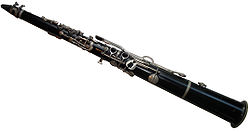Tárogató
 |
|
| Other names | Taragot, Töröksíp |
|---|---|
| Classification | |
| Playing range | |
|
Written Range: B♭3 to C6 (scientific pitch notation) Note: Romanian-made instruments may have difficulty reaching the upper range. |
|
| Related instruments | |
Written Range: B♭3 to C6 (scientific pitch notation)
The tárogató (töröksíp, Turkish pipe; plural tárogatók or, anglicized, tárogatós; Romanian: taragot or torogoata) refers to two different woodwind instruments commonly used in both Hungarian and Romanian folk music. The modern tárogató was intended to be a recreation of the original tárogató, but the two instruments are thought to have little in common.
Mention of the tárogató in Hungarian writings dates back at least as long ago as the 15th century. It is not clear whether it was first brought into Europe by the Hungarians when they first emigrated from the east in the 9th century. It is certain, however, that instruments of this type, descended from the Middle Eastern zurna, were introduced into Eastern Europe by the Turks in the Middle Ages, as evidenced by the term töröksip—"Turkish pipe"—which was used as a synonym for tárogató. It is possible that instruments from both traditions were combined into one entity. The tárogató has a Turkish origin, and it appeared in Hungary during the Turkish wars. Up to about the 18th century, the tárogató was a type of shawm, with a double reed, conical bore, and no keys.
Being a very loud and raucous instrument, the tárogató was used as a signaling instrument in battle (like the bugle or the bagpipe). However, depending on the type of reed used, it can also give off a very subtle, and yet, deep, mellow sound when played at a relaxed, steady pace.
Because the tárogató was an iconic instrument of the Rákóczi's War for Independence (1703–1711), its use was suppressed in the 18th century by the Habsburg monarchy. The instrument was eventually abandoned, being considered too loud for a concert hall.
...
Wikipedia
